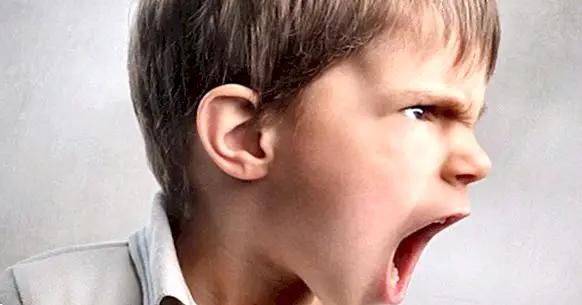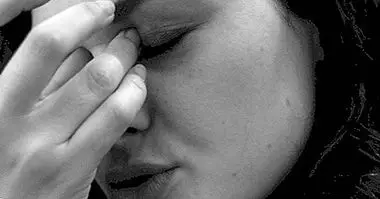Disruptive Disruptive Disorder of the Mood: symptoms and treatment
Irritability and rabies access in minors of these is one of the most recurrent reasons in psychology clinics and centers. Although these reactions are relatively common in these stages, their chronicity and intensity must be controlled.
When these accesses are too accentuated and occur too frequently they can be diagnosed as a Disruptive Disruptive Disorder of the Mood . Next we talk about its symptoms and treatment, as well as the controversy that surrounds this concept.
- Related article: "The 6 types of mood disorders"
What is Disruptive Disruptive Disorder of the Mood?
The Disruptive Disruptive Disorder of the State of Mind (TDDEA) is a relatively new term in clinical psychology and psychiatry which refers to a disturbance of the mood of the boy or girl . During this the child shows manifestations of chronic irritability and disproportionate mood swings compared to the situation.
Although these symptoms can also be seen in a wide variety of psychological disorders in children, such as bipolar disorder, Defiant Negative Disorder (ODD) or the Attention Deficit Hyperactivity Disorder (ADHD), the idea of creating a new concept such as the TDDEA was based on the aim of being able to include tantrums and cholera access to the diagnosis.
The incorporation into the DSM-V of this new label for child behavior has been widely criticized by professionals in psychology and pedagogy, as well as by researchers in behavioral sciences. One of these criticisms is the questioning of if it is really necessary to create more labels for child behavior , since these tend to create a stigma on the child both personally and socially.
On the other hand, the diagnostic criteria do not take into account the family, school or social context of the child , which can exert a great influence on both your mood and behavior, and may be the real cause of these explosions of anger and anger.
Finally, it has been questioned whether this disorder was substantially different from the others already discussed. However, according to certain studies there is a disparity in the etiology, as well as in the evolution and in the neurobiological bases.
Differences with pediatric bipolar disorder
There are many cases of putative disorders of disruptive dysregulation of mood that, due to the similarity between the symptoms of both conditions, have been diagnosed as pediatric bipolar disorder.
The main difference between the two is that, as in bipolar disorder, the youngest child has well-defined episodes of depressed mood and mania, children diagnosed with TDDEA. do not experience these different episodes so precisely or delimited.
In bipolarity, specific episodes are interspersed with moments of euthymia, while in the TDDEA the periods of change are much more persistent and random.
Symptomatology of the TDDEA
In order to make a satisfactory diagnosis of the TDDEA, without having to load the child with unnecessary labels, the diagnostic volume of this disorder, including its symptoms and symptoms, is described in the fifth volume of the Diagnostic and Statistical Manual of Mental Disorders (DSM-V). your exceptions. These criteria are:
- Symptoms present in children between 6 and 18 years old old.
- Severe and recurrent cholera outbreaks in response to common stressors. These outbursts must be inconsistent with the level of development of the child, the mood between rabies accesses must be irritable or irascible and the average cholera access must be at least three times a week.
- Symptoms begin before 10 years of age.
- Persistent symptomatology for at least 12 months.
- The symptoms they have not disappeared for three or more months in a row .
- The symptoms must appear in at least two of the following contexts: home, school, social context; being serious in at least one of them.
- Symptoms can not be better explained by any other medical condition, nor by the consumption of any drug or substance.
- The symptoms do not correspond to the criteria of a manic or hypomanic episode for more than a day.
- The symptoms do not meet the criteria for a major depressive episode.
It is necessary to specify that this diagnosis can not be made before 6 years of age, since in these stages tantrums and tantrums, as well as explosions of anger, are habitual and normative.
On the other hand, the DSM-V specifies the impossibility of this disorder being at the same time as a bipolar disorder, a defiant negativist disorder or an intermittent explosive disorder.
Effects and consequences of the TDDEA
According to evaluations and studies from the field of child psychology, it can be seen that approximately 80% of children under 6 years of age express temper tantrums more or less recurrently, becoming severe in only 20% of cases.
So that this anger or aggressiveness can be considered pathological it must interfere in the minor's daily life, as well as in his academic performance and in the daily family dynamics. As for the family environment, this disorder tends to generate a great impotence and disorientation in the parents of the affected children, since they are unable to manage or control the behavior and acts of the child; fearing to impose punishments that are too rigid or, on the contrary, too lax.
As far as the child is concerned, the irascible behavior ends up affecting the relationship of this with their peers or equals , which do not understand why their behavior. In addition, the levels of frustration he feels are so high that his attention span eventually diminishes, hindering his academic progress.
Treatment
Due to the novelty of the concept, the treatment of TDDEA is still in the process of research and development by the clinical professionals. However, the main protocol for intervention in these cases includes the combination of drugs with psychological therapy.
The medication of choice are usually stimulant drugs or antidepressant medications, while psychotherapy consists of an applied behavioral analysis . In addition, the active role of parents in the treatment is highlighted, since they must learn to manage the changes in the child's mood in the best possible way.
The pharmacological treatment of disruptive dysregulation disorder of mood is another of the points for which this condition has received numerous criticisms, questioning the real need to medicate children.



















